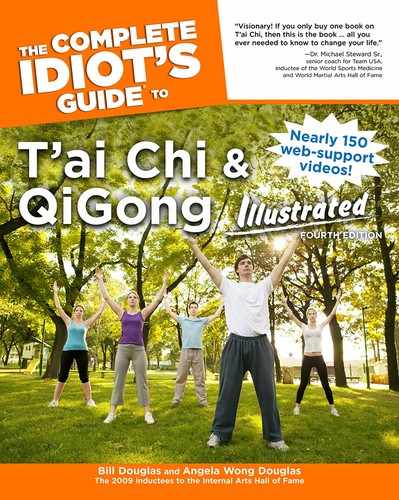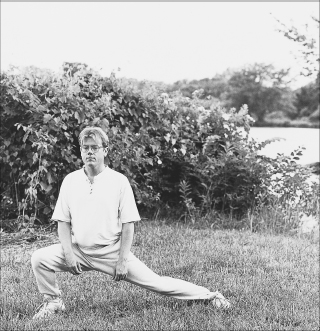Chapter
11
QiGong Warm-Up Exercises
In This Chapter
• Using warm-ups to calm and center
• Loosening the body and the mind
• Healing your joints while perfecting your balance
• Cleansing your tissues and your mind
• Web Video Support: Shaking Loose the Tension
T’ai Chi warm-up exercises are meant not only to warm the muscles and other tissues, but also to center the mind. You cannot listen to the radio or watch TV while warming up for T’ai Chi.
Of course, there are exceptions to every rule: when you get to the “Let the Dan Tien Do the Driving”; the “Filling the Sandbags, Sinking the Qi”; and the “Deep-Sinking Your Qi” sections of this chapter, you’ll be encouraged to view the related Web Video Support excerpts.”
Unlike the way many of us were taught to stretch out our muscles when warming up by using straining stances, T’ai Chi warm-ups start from the very center of our being. We begin by becoming self-aware of that center and then relaxing ourselves from the deep skeletal muscles outward. We prepare ourselves for fluid and effortless movement by allowing our body to relax around our breathing lungs, and then all the muscles relax on top of the moving skeleton.
Each warm-up is a form of QiGong and promotes health and healing on many levels. These warm-ups are a beneficial exercise program even without T’ai Chi, but T’ai Chi offers so much more.
Letting Your Dan Tien Move You
When we start our Sitting QiGong, warm-ups, or T’ai Chi movements, our minds are usually scattered. We are thinking about what we need to do at work, what we need to do to prepare dinner tonight, and so on. So the first task of warm-ups is to center our minds, and the center of our physical being is, as you know, the dan tien. However, the center of our mind and heart is the breath. View Breathing into Your Center Web Video Support.
There’s nothing more calming and centering than hearing and feeling your own breath. Therefore, all T’ai Chi–related exercises begin by simply closing your eyes and feeling the rhythm of your own breathing:
• Let your eyes close easily and naturally as you stand comfortably with your feet fairly close together and knees slightly bent. See Web Video Support’s How to Bend the Knees.
• Notice how your lungs fill and empty. Think of breathing into the bottom or abdominal part of the lungs and then letting the top or chest area fill.
• As you breathe, allow the muscles in your head and torso to let go. This allows the breaths to become not only deeper, but also more and more effortless, almost as if the breath were beginning to breathe you.
| SAGE SIFU SAYS |
• Let your awareness (or mind) relax, riding on the rhythm of your own breath.
• Now think of breathing down into the dan tien area. You can experience the slight expanse of the upper pelvic and lower abdominal muscles as you breathe in, and notice how those muscles relax in as you release the breath.
• You may experience a feeling of air expanding down into that area. Of course, the lungs don’t go down that far, so you are feeling the Qi, or your awareness, expanding through your dan tien area.
Revisit the Web Video Support’s Breathing into Your Center for a quick video tutorial on abdominal breathing.
Let the Dan Tien Propel Your Movement
The breathing exercises help your awareness expand in the dan tien area, which prepares you to let the dan tien be the movement. This may sound a little odd at first, but after playing the following exercises for a while, it’ll be quite natural and will dramatically improve your focus, balance, and movement. The first two T’ai Chi warm-up exercises employing hip rotations help you practice this. See the Web Video Support’s Moving QiGong: Dan Tien Massages the Body for an exhibition of the first of the following warm-ups and more on letting the dan tien do the driving.
| SAGE SIFU SAYS |
1. With your feet close together, let the dan tien, or hips, begin a counterclockwise rotation, sort of like a hula-hoop motion. If you were looking down at a clock face beneath your feet, you would be going counterclockwise.
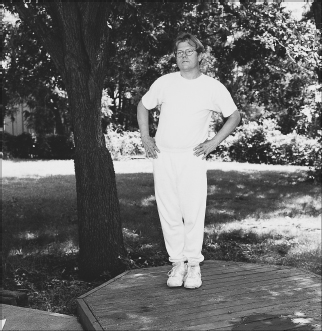
Feet together, rotating hips in hula-hoop fashion.
Notice that the dan tien begins to move effortlessly like a gyroscope in motion, allowing you to let your muscles relax while the dan tien moves the skeleton underneath. The shoulders don’t move too much; most of the motion is in the dan tien, or hip area. However, don’t be rigid about this. The goal is to get loose.
2. Repeat the counterclockwise hip rotations 32 times, if that feels good to you, and then repeat 32 times in the opposite direction, clockwise.
Close your eyes as you rotate the dan tien. At first this may challenge your balance, but you’ll get better. With your eyes closed, your awareness can go within. You will notice areas of the body loosening as you rotate and breathe. Think of letting the muscles let go of bones and other tissue, allowing the body to just generally loosen on top of the skeleton. You will notice the lower-back vertebrae loosening as the muscles around them begin to let go. You will also notice this loosening spreading up the back through the lumbar region, up through the dorsal vertebrae between the shoulders, and into the neck and the back of the head. Basically, anywhere you let your light of awareness shine within, your body, mind, or heart can begin to loosen as you breathe effortlessly and move effortlessly in these dan tien rotations.
| OUCH! |
3. Now repeat the hip rotations both ways (first counterclockwise and then clockwise), with your feet about shoulder-width apart and knees slightly bent. Relax and enjoy the sensations of movement. With the feet farther apart and eyes closed, you will notice that you can very tangibly feel the top of the femur or hipbone rotating in the hip socket. Slow the rotations, and you will feel the hipbone rotating all the way around the inner rim of the hip socket.
Enjoy the deep-tissue massage the rotating bones give, as the deep hip muscles begin to let go of the tensions built up there. As you breathe and let muscles relax on top of the moving skeleton, you can enjoy this loosening through the back, legs, and the rest of the body.
The enjoyment of this internal loosening helps us almost see inside ourselves. Practicing this pleasant internal vision is a powerful health tool. By becoming aware of how good effortless motion feels inside, we also become aware of tensions or diseases at a very early stage before they actually become diseases.
| SAGE SIFU SAYS |
In T’ai Chi warm-ups, we don’t strain to stretch out our muscles. We allow ourselves to lengthen until we begin to ease up against strain. The tension we become aware of indicates a block. Then we take a deep breath, and as we exhale, we allow light, or Qi, to fill the area of tension or restriction, which lets the block begin to let go. You can actually feel the lightness or release spread effortlessly through a tight or restraining muscle as you let out the breath. Our mind’s awareness of the block directs the Qi, or energy, into the center of the block as we let the breath relax out of our bodies.
1. With your fingers interlaced, extend your hands up over your head. See Web Video Support’s Moving QiGong: Elongated, Not Stretched. And do the exercise with this text instruction afterword, because there are details of “letting go” here that go beyond the video.
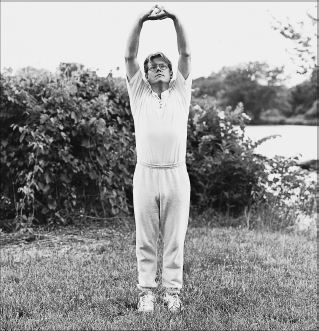
Fingers interlaced, stretching upward.
2. Don’t stretch, but allow your body to be effortlessly lengthened, as if the hands were being lifted up toward the sky.
3. As you release each sighing exhale, think of letting the muscles beneath the muscles let go.
4. Enjoy the feeling of effortless release through the back, shoulders, neck, and head, and down into the hips and legs. As you breathe and let go, the entire body gets a bit of a stretch.
5. Now stretch out to either side, but rather than thinking of stretching, think of the hands being drawn out and upward toward the sky, out to the left and then the right. First the hands are drawn outward and up off to the right side of the body, and then easing back upward and over to the left side.

Hands extended, but now stretching over sideways.
6. Go back and forth. Don’t stretch so far to the side that you feel a big strain. Rather, go just far enough that you can savor the sensation of the muscles stretching across the back, between the shoulders, and through the neck. Again, as you loosen, the entire body gets a bit of a soothing, effortless stretch.
7. Now lengthen straight up again before stretching out and forward. The back should be fairly straight, bending from the hips and letting the arms just hang down.
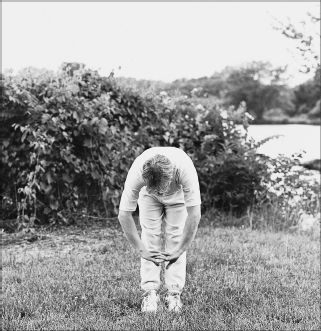
Back bent flat, with hands hanging down.
8. Don’t strain to touch your toes. That’s not the point. The point is to feel an effortless lengthening through the upper body as you simply let go. As you hang loosely, some of the weight of the world is pulled off and out of you by gravity’s gentle cleansing pull. On each exhale, surrender yourself to that unloading. The earth’s gravity is like the planet giving you a hug, as with each sighing exhale you surrender yourself into its embrace, allowing it to draw your burdens from you.
9. Enjoy that feeling of effortless elongation through the shoulders, neck, and back of the head. Notice that with each releasing exhale, you can let go even more. With each releasing breath, the muscles in the head can let go even more, showing you that relaxation is not a destination, but an endlessly enriching process of letting go. Think of the heart, just hanging in the chest, releasing any of the tight feelings it’s been hanging on to, as it, too, exhales and releases itself to sink down and out of you. Think of the brain just hanging in the skull, releasing any of the tight thoughts you’ve unconsciously squeezed in your mind. Feel the scalp actually begin to relax off the skull, as that tingly lightness permeates both skull and scalp.
10. Again, interlace the fingers, and then slowly and gently straighten the lengthened back up to the original position, with hands interlaced high over the head.
11. With your eyes closed, take a deep breath. On the sighing exhale, allow the hands to descend to the sides so slowly that you can feel the air passing between the fingers. As the hands arc down from above the head, out to the sides, and the breath relaxes out, experience the different muscle groups letting go through the head, face, jaw, neck, shoulders, torso, arms, legs—even into the hands and feet. Feel a deep letting go in the field within, throughout, and all around you … releasing everything, even down into the earth below.
12. Let each exhale trigger a deeper letting go from the very center of your being, as if the bones themselves could let go. Allow every cell in the body relax those breaths out.

Hands descending to the sides.
13. As you stand with your eyes closed, continue to let go of all the muscles with each breath, and also let go of the heart. Just as the muscles release tensions with each sigh or yawn, the heart can let go of tensions or loads it has squeezed in the heart muscle or muscles around the heart.
14. Think of the brain or mind letting go. Just as the cranial muscles let go of their grip on the skull, the mind can release worries and mental tensions with each releasing breath.
15. Realize that each breath can trigger a deep cleansing on many levels—mental, emotional, and physical. With each exhale, experience a deep letting go. Give yourself a few moments with eyes still closed to marinate in this field of soothing expanding lightness that you are. These exercises don’t create this field of lightness, they just help us unload the tension dust, to allow the incredible lightness of being that we are to shine through.
Sinking the Qi Is Like Filling a Sandbag
Settling down into the Horse Stance is sinking your weight down into both feet as if you were sinking down into a saddle on a horse. The tailbone drops as the pelvis tilts slightly up, and the head is drawn upward toward the sky, while the chin is pulled slightly in. This causes the spine to lengthen, which is great for the back, releasing a lot of the pressure daily stress puts on it. Moving from the Horse Stance not only improves posture and balance, but it can also preserve your joints and make you more powerful.
Revisit the Web Video Support’s Sinking into the Horse Stance for a video supplement of this settling into the Horse Stance instruction.
After you settle in the Horse Stance, let the dan tien flow back and forth from one leg to the other. Picture yourself sitting on an office chair with wheels, rolling from side to side. Or as if you were sitting on the back of a park bench, sliding your bottom from side to side. Notice that the head and shoulder never lead the way, nor do the hips stick out from side to side. The upper body stays stacked above the dan tien as it flows back and forth. View the Web Support Video’s Filling and Emptying to get a sense of the following, more detailed exercise instructions.

Note that while in Horse Stance, the knees are slightly bent and the upper body is stacked above the dan tien, erect but relaxed and not rigid.
As you become aware of discomfort or tension—the fatigue you may feel in the muscles above the knees, for example—play the following game.
1. Let yourself feel the tension or discomfort, wherever it is in your body.
2. Experience how it feels and where you feel it.
3. Now, as you let the next breath out, think of letting the light, or Qi, expand right in the center of that feeling.
4. Let your awareness sit back and enjoy whatever responses you experience. Often you will experience a lessening of the discomfort or even a pleasure of the expanding lightness.
| OUCH! |
In T’ai Chi, the upper body does not lean; it stays stacked up above the dan tien, just like in the Horse Stance. The dan tien flowing toward one leg fills that leg with the Qi, or energy (or the weight of your body). Simultaneously, the leg the dan tien moves away from is emptying of Qi, or weight. In T’ai Chi, you rarely ever pivot a leg that has weight on it because it makes your balance precarious. More important, it damages the knees to pivot feet that bear weight. So this Moving from the Dan Tien exercise teaches you to shift your weight from one leg to the other. This simple exercise is the most important T’ai Chi warm-up because this is what T’ai Chi is. All of T’ai Chi’s elaborate forms are based on the dan tien moving from one leg to another.
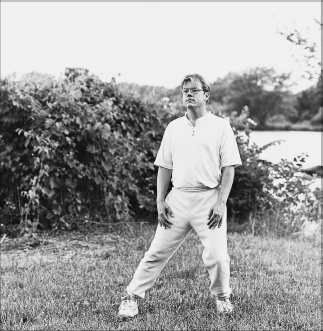
Flowing upper body to the other side.
If your mobility permits and you feel adventurous, you can practice a Deep Sinking of the Dan Tien exercise. Also refer to the Web Video Support’s Deeper Filling and Emptying for a video supplement of the instructions here. Realize that you do not have to do this exercise to get T’ai Chi and QiGong’s benefits. This will be too deep for many, so don’t feel like you must do this in order to be successful at T’ai Chi or QiGong. However, you may be surprised in a few months or years to find that you can enjoy this because your practice has loosened you and improved your balance so profoundly.
Note that as the dan tien drops deeply down into one leg by bending that knee, the back is not bent over. As always, you don’t bend, but you keep the upper body stacked up above the dan tien.
Deep bending of one knee with back straight.
The Chinese Drum’s Kaleidoscopic Sensations
The Chinese Drum mimics the motion of those little toy drums with the two swinging beads. See Web Video Support’s Chinese Drum Turns. When the drum is turned from side to side, the beads twist and drum alternately on each side. This is how your relaxed arms and hands will gently strike your body, as you follow these instructions:
1. Stand up with your feet about shoulder-width apart and knees, as always, slightly bent. Gently turn, swinging your arms out. The lead arm swings across the back to strike the flank or lower back, as the trailing arm swings across the front of the body to strike the shoulder.
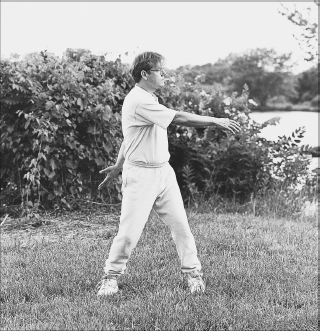
Turning and arm swinging out from body.
2. As the hands strike the shoulder and flank in back, close your eyes and enjoy the physical contact. The gentle slapping begins to massage the muscles as you turn back and forth, alternately slapping each flank and shoulder in turn.
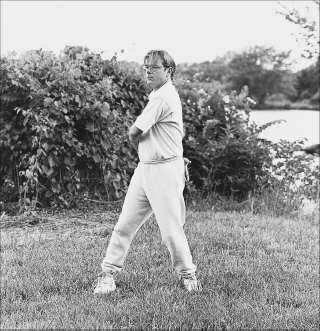
Hands striking body in back and shoulder.
3. Let your mind release any analytical or problem-solving thoughts, and simply open to the pleasure of the motion.
4. With each turn and releasing breath, allow the body to let go even more.
5. Let the mind relax into the pleasure of that letting go, allowing the mind to experience the tens of thousands of sensations throughout the body.
6. With your eyes closed, you can attune yourself to the sensations of the pads of the feet shifting on the floor, the interactions of bones and muscles throughout the body, and the releasing pleasure of each breath. Feel the wind on your skin as you turn through space.
7. Even with your eyes closed, patterns of light and shadow flow across your eyelids, and sounds both internal and external flow over and through you.
8. Don’t try to hear, feel, or see. Rather, let your mind relax and allow sensations, images, and sounds to pour over and through your mind the way clear mountain water pours over a waterfall.
Let the mind give up straining to function or reaching out to the world, but rather allow the world to flow to you in a soothing experience of effortlessness. Think of your mind releasing its grip on the dock of logical thought and floating down a river of kaleidoscopic sensation, carried on the beauty of existence, savoring the ability to breathe, flow, and experience sensation … effortlessly.
Deep-Tissue Cleansing Leaves You Radiant
QiGong provides many deep-tissue cleansing exercises, and the following is only one of them. It contains two parts that should be practiced gently and, as always, with awareness of your own mobility range.
Fling Off and Exhale the Weight of the World
Most of the tensions we carry around are energy we’ve squeezed in our minds, our hearts, and the muscles in the body. You know this is true because on days when you feel heavy and weighted down by the world, if you get on a scale, you don’t weigh any more than usual. Therefore, we can simply fling off much of the loads we lug around. See Web Video Support’s Fling Off the Weight of the World.
1. Begin with your hands above your head and then simply swing them gently outward and downward, flinging off the weight of the world you’ve held in your body.
2. Think of letting the bone marrow itself exhale and release the loads it’s been holding on to, which, of course, it can release.
3. As the hands fling toward the ground, think of the hands and feet opening to release that load to fly out of you into the cleansing earth. As your hands swing out and down, exhale deeply to facilitate the release.

Hands up high, ready to swing out and down.
4. Breathe in as you raise the hands back up over the head, and again release all as you swing the hands out and down again. Repeat several times.
Experience Your Incredible Lightness of Being!
This tissue-cleansing exercise is a fun and soothing jiggling of your entire being that you can practice several times per day to shake the tension dust out of your energetic being. See Web Video Support’s Shaking Loose the Tension for a visual example of this, and then read through the following text instruction for an even deeper awareness of what you should feel as you do this. A couple of years ago, I caught a news report about a hip new club in New York where people paid a hefty entrance fee to do this very same thing, and they reported that they felt terrific afterward. Enjoy!
1. With your feet about shoulder-width apart, eyes closed, and knees slightly bent, take a deep full breath and then just let your dan tien and skeleton jiggle. Gently let the arms and entire body go liquid and loose. Don’t jolt the joints, but allow a liquid wave to ripple through every muscle and joint. It’s almost as if the field of energy that you are is vibrating you at the roots of your being, as you just relax out of the way more and more with each releasing breath, as if your entire being could exhale, and let go.
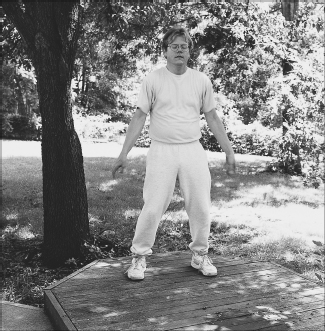
Let yourself go as liquid and limp as you can, with your eyes closed, enjoying a loosening throughout your being.
| T’AI SCI |
2. Experience the deep skeletal muscles going liquid on the bones, from the top of the head to the pads of the feet. It’s very slight and very subtle, but as those muscles loosen, they begin to cleanse the body of deep toxins. Think of the brain and heart loosening as well, letting worries, angst, and tensions evaporate out of the body with each yawn or sighing exhale. Yawn anytime and every time you feel like it.
3. Even the bones are being shaken and loosened on that subtle energetic level. Think of the bones exhaling and letting go of that bone tiredness they squeeze onto. Feel the tendons, cartilage, and connective tissue all loosening throughout your frame, as all the 50 trillion cells you are made of are gently shaken loose.
4. Notice the rib cage loosening in your torso, and as it exhales you feel it ever more easily jostled inside you.
5. The cranium, cranial muscles, and even the brain are being loosened by this gentle vibration shaking through you. Think of the brain exhaling, and letting go, to be even more loosened and massaged by the motion shaking through your head.
6. Now the spine and spinal fluid, and all the miles and miles of nerves through your body are being shaken out like a dusty sheet in the wind, releasing their static tension loads into the expanding lightness that you are.
7. Enjoy one last good series of shakes while taking in a nice, full breath. On the long, sighing exhale, stop shaking, and with the eyes still closed, just feel the body awakening—the tingly lightness expanding through you—losing that definition of skin, and opening up to this lighter, larger energetic beingness that you are. Notice how every cell expands open with a radiant lightness, clear, clean, and alive. Wherever you notice remaining tension or block, with each releasing breath, think of allowing the light to expand in that area as if the body were expanding endlessly outward. You don’t make it happen, you just let go deeper with each breath, releasing any heavy loads to evaporate in that endlessly expanding lightness.
The Least You Need to Know
• The dan tien makes all movement effortless.
• Let warm-ups loosen your entire being and be almost a sensory amusement park.
• Moving from the Horse Stance is the most important warm-up exercise.
• The Chinese Drum cleans your mind and body.
• Doing warm-ups with your eyes closed helps the mind relax within.
